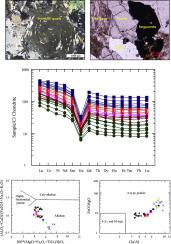Lithos ( IF 2.9 ) Pub Date : 2020-12-27 , DOI: 10.1016/j.lithos.2020.105956 Bassam A. Abuamarah , Mokhles K. Azer , Paul D. Asimow , Qingshang Shi

|
At Hadhb't Ad-Dayheen, in the central Arabian Shield, a post-collisional igneous complex called the Ad-Dayheen intrusion is exposed. It was emplaced in the Early Ediacaran (613–625 Ma), during the final tectono-magmatic stage of Arabian Shield development. Despite limited and discontinuous ring-shaped outcrops due to alluvial cover and later faulting, three pulses of intrusion can be recognized in the field: an early pulse of monzogranite; a second pulse of syenogranite and alkali feldspar granite; and a final pulse of alkaline and peralkaline granite, mineralized microgranite, and pegmatite. Samples show distinctively low contents of CaO, MgO, and Sr in contrast to elevated concentrations of alkalis, Rb, Nb, Y, Ta, Hf, Ga, Zr and rare-earth elements (REE); these are common characteristics of post-collisional rare-metal-bearing A-type granites. The suite displays positive Nb–Ta anomalies and pronounced negative Eu anomalies (Eu/Eu* = 0.11–0.35). The alkaline/peralkaline granites and microgranite of the Ad-Dayheen intrusion feature disseminated mineralization, whereas mineralization is localized in the pegmatite. The primary magma feeding the Ad-Dayheen intrusion was mostly generated by partial melting of the juvenile crust of the Arabian Shield, with a minor mantle contribution. We argue that an episode of lithospheric delamination led to crustal uplift, erosional decompression, and generation of mantle melts that supplied heat to drive crustal melting. The anatectic deep crustal melts assimilated a F-bearing component that also added rare metals to the magma. Each pulse can be described by a fractional crystallization model, but the parental liquid of each subsequent pulse was first modified by further addition of fluorine and rare metals and loss of CaO, Sr, Ba, and Eu due to fluorite fractionation. Texture and morphology of the ore minerals indicate that mineralization (U, Th, Zr, Nb, Ta, Y, Hf and REE) took place in two stages: a magmatic stage coinciding with emplacement of the intrusion, followed by a hydrothermal stage. The magmatic process enriched the residual melt in high field strength elements (HFSE) and REE. The later hydrothermal stage further localized these elements and increased their concentrations to economic grades. The pegmatite is highly mineralized and contains high concentrations of U (81–179 μg/g), Th (244–600 μg/g), Zr (2397–14,927 μg/g), Nb (1352–2047 μg/g), Ta (96–156 μg/g), Y (828–2238 μg/g), Hf (131–377 μg/g) and ∑REE (1969–4761 μg/g).
中文翻译:

碰撞后含稀土的Ad-Dayheen花岗岩侵入岩的成因,中央阿拉伯盾
在阿拉伯盾牌中心的Hadhb't Ad-Dayheen,一个名为Ad-Dayheen侵入的碰撞后火成岩被暴露出来。在阿拉伯盾发展的最后构造-岩浆阶段,它被安置在早期的Ediacaran(613–625 Ma)中。尽管由于冲积层和后来的断层而使环状露头有限且不连续,但在该领域中仍可以识别出三个侵入脉动:早期的辉长花岗岩脉动;二次花岗岩和碱长石花岗岩 最后是碱性和高碱性花岗岩,矿化微花岗岩和伟晶岩。与碱,Rb,Nb,Y,Ta,Hf,Ga,Zr和稀土元素(REE)的浓度升高相比,样品中CaO,MgO和Sr的含量明显较低。这些是碰撞后含稀土的A型花岗岩的共同特征。该套件显示正Nb-Ta异常和明显的负Eu异常(Eu / Eu * = 0.11-0.35)。Ad-Dayheen侵入岩的碱性/高碱性花岗岩和微花岗岩具有弥散的矿化作用,而矿化作用则集中在伟晶岩中。造成Ad-Dayheen入侵的主要岩浆主要是由阿拉伯盾的少年外壳部分融化产生的,而地幔贡献较小。我们认为,岩石圈分层的发生会导致地壳隆起,侵蚀性减压以及产生地幔融化,从而提供热量来推动地壳融化。阳极深地壳熔体吸收了含F的成分,该成分也向岩浆中添加了稀有金属。每个脉冲可以用分数结晶模型来描述,但随后的每个脉冲的母液首先通过进一步添加氟和稀有金属以及由于萤石分馏而导致的CaO,Sr,Ba和Eu损失而得到改性。矿石矿物的质地和形态表明,成矿作用(U,Th,Zr,Nb,Ta,Y,Hf和REE)分两个阶段发生:岩浆阶段与侵入岩的侵入相吻合,然后是热液阶段。岩浆作用富集了高场强元素(HFSE)和REE中的残余熔体。后来的热液阶段进一步使这些元素局部化,并将其浓度提高到经济等级。伟晶岩矿化度高,并含有高浓度的U(81–179μg/ g),Th(244–600μg/ g),Zr(2397–14,927μg/ g),Nb(1352–2047μg/ g), Ta(96–156μg/ g),Y(828–2238μg/ g),Hf(131–377μg/ g)和∑REE(1969–4761μg/ g)。











































 京公网安备 11010802027423号
京公网安备 11010802027423号